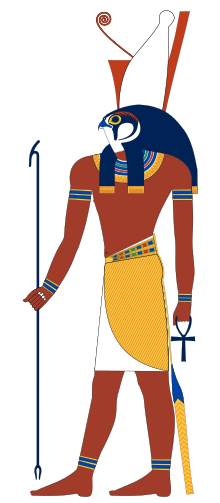For Christians, the season of Advent serves as a reminder both of the original waiting that was done by the Hebrews for the birth of their Messiah as well as the waiting of Christians for Christ's return.
http://en.wikipedia.org/wiki/Advent
The winter solstice occurs exactly when the axial tilt of a planet's polar hemisphere is farthest away from the star that it orbits. The seasonal significance of the winter solstice is in the reversal of the gradual lengthening of nights and shortening of days. Depending on the shift of the calendar, the winter solstice usually occurs on December 21 or 22 each year in the Northern Hemisphere, and June 20 or 21 in the Southern Hemisphere.[3]
Worldwide, interpretation of the event has varied from culture to culture, but most cultures have held a recognition of rebirth, involving holidays, festivals, gatherings, rituals or other celebrations around that time.[4]
http://en.wikipedia.org/wiki/Winter_Solistice
Horus is one of the oldest and most significant deities in the Ancient Egyptian religion. These various forms may possibly be different perceptions of the same multi-layered deity in which certain attributes or syncretic relationships are emphasized, not necessarily in opposition but complementary to one another, consistent with how the Ancient Egyptians viewed the multiple facets of reality.[2]
The earliest recorded form is Horus the Falcon who was the patron deity of Nekhen in Upper Egypt and who is the first known national god, specifically related to the king who in time came to be regarded as a manifestation of Horus in life and Osiris in death.[1] The most commonly encountered family relationship describes Horus as the son of Isis and Osiris but in another tradition Hathor is regarded as his mother and sometimes as his wife.[1] http://en.wikipedia.org/wiki/Horus
Horus was often the ancient Egyptians' national patron god. He was usually depicted as a falcon-headed man wearing the pschent, or a red and white crown, as a symbol of kingship over the entire kingdom of Egypt. | |
| God of the king, the sky and vengeance | |
| Major cult center | Nekhen, Behdet Edfu |
|---|---|
| Symbol | The wedjat eye |
| Parents | Osiris and Isis in some myths, and Nut and Geb in others. |
| Siblings | Anubis (in some accounts) or Osiris, Isis, and Nephthys |
| Consort | Hathor (in one version) |
In Haitian Vodou, Papa Legba is the intermediary between the loa and humanity. He stands at a spiritual crossroads and gives (or denies) permission to speak with the spirits of Guinee, and is believed to speak all human languages. He is always the first and last spirit invoked in any ceremony, because his permission is needed for any communication between mortals and the loa - he opens and closes the doorway[1]. In Haiti, he is the great elocution, the voice of God, as it were. Legba facilitates communication, speech and understanding.He usually appears as an old man on a crutch or with a cane, wearing a broad brimmed straw hat and smoking a pipe, or sprinkling water. The dog is sacred of him. Because of his position as 'gate-keeper' between the worlds of the living and the mysteries he is often identified with Saint Peter who holds a comparable position in Catholic tradition. He is also depicted in Haiti as St. Lazarus,[2] and St. Anthony. [3]
In Benin and Nigeria, Legba is viewed as young and virile, is often horned and phallic, and his shrine is usually located at the gate of the village in the countryside.
Simon Peter is venerated in multiple churches and is regarded as the first Pope by the Roman Catholic Church.
Capricorn' (♑) is the tenth astrological sign in the Zodiac, originating from the constellation of Capricornus. In astrology, Capricorn is considered an introvert sign,[1] an earth sign, and one of the four cardinal signs. Capricorn is ruled by the planet Saturn. Individuals born when the Sun was in this sign are considered Capricorn individuals. Under the tropical zodiac, the Sun enters Capricorn by definition at the moment of winter solstice, or roughly at December 22, and leaves it around January 20.
The Parable of the rich man and Lazarus (also called the Dives and Lazarus or Lazarus and Dives) is a well known parable of Jesus which appears in one of the Four Gospels of the New Testament.
According to Gospel of Luke (Luke 16:19–31), the parable tells of the relationship, in life and in deathMany allusions to Lazarus (particularly those involving the idea of resurrection from the dead) should be understood as referring to the Lazarus described in John

Anthony of Padua or Anthony of Lisbon, O.F.M., (born Fernando Martins de Bulhões; 15 August 1195 – 13 June 1231)[1] was a Portuguese Catholic priest and friar of the Franciscan Order. After his ordination to the priesthood, Fernando was named guestmaster and placed in charge of hospitality for the abbey. It was in this capacity, in 1219, that he came into contact with five Franciscan friars who were on their way to Morocco to preach the Gospel to the Muslims there. Fernando was strongly attracted to the simple, evangelical lifestyle of the friars, whose order had been founded only eleven years prior. In February of the following year, news arrived that the five Franciscans had been martyred in Morocco, the first to be killed in their new order.
St. Anthony, is the Patron Saint of Lost items, things that make you go HUMmmm???





No comments:
Post a Comment